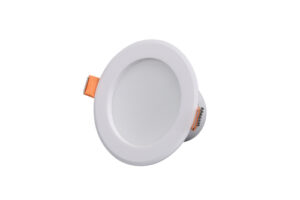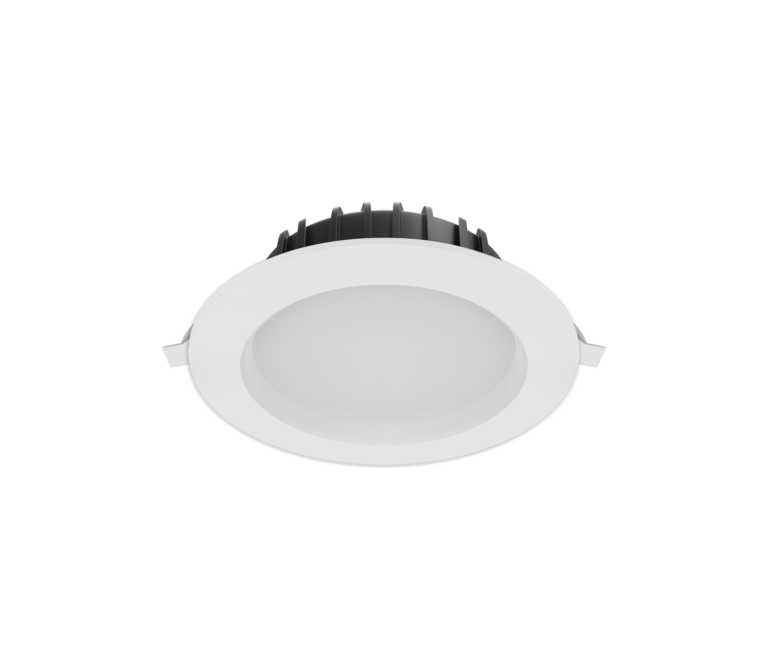As more and more homeowners adopt new and high efficiency LED lighting, LED downlights flickering has become a common problem.
History & Causes of Flicker

When LED lighting first appeared, dimming was a very hit and miss affair. More modern developments of both dimmers and LED lighting have made major improvements, but flickering LED downlights continues to be a significant problem.
One of the main reasons for LED downlights flickering is that not all LED lights or LED dimmers are created equal:
- Most LED downlights and dimmers are built to a price, not to a performance level;
- There is a wide variation in the quality of the LED’s inside;
- The dimmer is not suitable or well-matched for LED lamps;
- The lamps are not suitable or compatible with the dimmer being used.
Many LED lights claim to be ‘dimmable’ but are unable to be dimmed to 0% brightness or will flicker at either low or high brightness.
In some regions, control signals by power utilities cause flicker at certain times of day. This needs a completely different technical cure.
If you have these problems with LED Downlights Flickering, read on for diagnosis and solutions.
Diagnosis – Working out the cause of your problem
STEP 1: Take notice of when the flickering happens. If it is always at the same time (for example: at night after 10 pm) this indicates a control signal by the power utility called Ripple Injection. This is described below with more information.
Step 2: When you updated to LED lighting did you change your dimmers as well? If not, you probably need to update the dimmers to a model that is compatible with LED lighting. Read below for more information.
Step 3: The dimmers and/or lights could be wired incorrectly. Ask an electrician to check your wiring.
Step 4: The dimmers could be overloaded causing the LED downlights flickering issues. Every dimmer has a maximum load, and this sets the number LED downlights that can be connected. If this is exceeded the dimmer will have problems and may make the lights flicker. Ask your electrician to double check the loaded maximum of the dimmer and the number of LED lights on that circuit.
Solving the LED Downlights Flickering Problem
The goods news is that in most cases, if quality products have been used, then flickering problems can be solved. However, there are some situations where there is very little can be done. These are covered first.LED Downlights Flickering Issue #1
RIPPLE INJECTION
This problem only affects LED downlight flickering in Australia in NSW and South East Queensland. If you are not located in these areas, then read on to issue #2. This problem is noticed as periodic flickering at regular intervals, typically evening and early morning. The cause is energy supply utilities transmitting signals called “Ripple Control” onto the mains. These signals control off-peak electric hot water systems. These high-frequency signals are received by all consumers connected to the grid in that area even if they don’t have tariff changing equipment installed in their switchboard. The signal is repeated a number of times in case it is not received correctly. When the Ripple Injection signal is transmitted, it shows as regular periods of LED downlights flickering, for 10 – 15 mins duration spread over an hour or more. This typically occurs in the late evening or afternoon and is more noticeable on lights controlled by dimmers. Most often the flickering of the lights is only noticeable when the lights are dimmed, the more dimmed the lights are the more noticeable the flickering. Ripple Control has been in use for many decades. Prior to LED lighting, the tungsten and halogen lamps held thermal inertia which helped reduce the effects of the flickering; even when those older types of lighting was used, Ripple Injection was a problem. In the last decade a large amount of solar generation has been added to electrical grids, and this has changed many grid properties and made Ripple Injection less reliable. Consequently, electrical power utilities have increased the magnitude of the Ripple signal, and this has tended to make the problem even worse. There is no cheap or easy fix. Filter products from Gayrad may assist, but you must do your own due diligence and care should be taken when selecting such devices. These kinds of filters must be installed by a licensed electrician. Update 2023 – Ozuno has a ripple tolerance device in development that can be inserted between a LED driver and the downlight. This dramatically reduces the effect of flickering caused by the Ripple Injection. This product is only suitable for downlights that have a separate lamp and driver, and requires an electrician to insert the product into the driver / lamp signal. This product is not yet commercialised while we gauge commercial viability. If interested, contact us.LED Downlights Flickering Issue #2
INCOMPATIBLE DIMMERS AND LED DRIVERS
When upgrading to LED lighting you must also update your wall dimmer. If the dimmer is not updated, there is a high chance of incompatibility between the electronics in the LED lamp and the dimmer. Older dimmers were never designed to dim LED lights. Expecting these old dimmers with ancient dimming technology to dim your LED lights is illogical and is unlikely to work – at least not to a performance level where most homeowners would be happy. Your electrician can fix this by also installing dimmers made specifically for dimming LED lighting and Australian conditions.
The Diginet LEDsmart+ range of dimmers, switches and timers have been designed in Australia by experts at Ozuno who have 30 years experience in dimmer design, with millions of products sold.
These products include Ripple Injection filtering, and are designed for Australian conditions and specifically for dimming LED light sources.
These product ranges are distributed exclusively by Pierlite in Australia and New Zealand.
LOAD Bypass to Stop LED Downlights Flickering
A Load Bypass device (MMBP) is an additional component which can be attached to the dimming circuit and provides improved dimming and switching performance of some problematic LED and CFL lamps. A Load Bypass Device can overcome the following issues, sometimes seen when controlling some LED or CFL light sources with electronic dimmers, switches, timers or sensors:- When switched off, the LED/CFL lights flicker, pulse on/off or do not switch off completely.
- When switching on, the LED/CFL lights have difficulty turning on and any dimmer backlights or indicators flicker or pulse.
LED Downlights Flickering Issue #3 & #4
IMPROPERLY WIRED AND/OR OVERLOADED DIMMERS
Check Wiring
This may seem obvious but is often overlooked. Is the wiring to the dimmer and the LED driver or fixture correct and terminations tight? If not the flickering you’re experiencing may simply be related to loose or incorrect wiring.Check Loads and Load Ratings
All dimmers, including LED dimmers, have a minimum and a maximum rated load. If the load on your dimmer is smaller than the minimum load rating of the dimmer then correct operation is unlikely. Change to a dimmer with the smallest possible minimum load rating. Sometimes, fitting a Load Bypass Device can help if the load on the dimmer is too small. If the load is greater than the maximum load rating of the dimmer, then performance will deteriorate and may materialise as LED downlights flickering. If the LED dimmer is rated at (for example) 400 W (400 Watts) and the electrician has done his maths correctly, there should be less than 400 Watts of LED lighting attached to that dimmer circuit.De-rate your dimmers
Often more than one LED dimmer – whether it’s a push button dimmer or a rotary dimmer – will be installed in the same switch-plate. Sometimes up to 6! When dimming a load, all dimmers generate a small amount of heat, and when many electronic dimmers are jammed into a small space, there is less space available to get the heat out. In these circumstances, to maintain performance and avoid LED downlights flickering, the maximum load of each dimmer must be reduced. This is called de-rating. All LED dimmers have different recommended de-rating factors, so check with the manufacturer. If you find that the dimmers are overloaded or have not been de-rated properly you have a few choices:- Remove sufficient LED lights from the circuit to match the new, de-rated load capacity of the dimmer.
- Install another switch plate and relocate some of the dimmers from one switch plate to the new switch plate.
Availability
LEDsmart, LEDsmart+ and the Load Bypass Device (PART# MMBP) are the best performing and highest selling dimmers in Australia and New Zealand for good reason – these products are designed for LED lamps, and “just work”.
Available from your local electrical wholesaler.
About Ozuno
Ozuno are industry veterans, and holders of a number of patents in the field of phase control dimming of LED lighting loads. The principals of Ozuno have designed every top-selling phase dimmer sold in Australia over the last 30 years.
Wall plate mounted phase dimming products design by Ozuno are sold and supported in Australia and New Zealand exclusively by Pierlite and are available through good electrical wholesalers.
For more technical information about phase dimming, how it works, and the properties of high quality phase dimmers for mains lighting loads, refer to our phase dimming tutorial.
For DALI-2 Phase Dimmers, please contact Ozuno directly.
